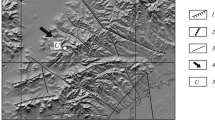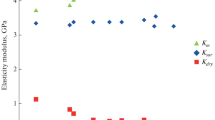Abstract
Kyrgyzstan is a mountainous country where more than 90% of the surface is occupied by mountains and almost all gold deposits are located in the highlands above 2700 m from sea level. The mountainous terrain, high seismicity and active tectonics form a special discrete anisotropic medium with an initial stress state. Assessment and management of the stability of the sides of quarries, underground workings and dumps in the zones of influence of tectonic disturbances is one of the urgent tasks in the development of high-altitude deposits. This article presents the results of studies of the properties of the rock mass and the determination of the physical and mechanical properties of the main enclosing rocks of deposits by assessing the effect of metamorphism on their stability.
Access provided by Autonomous University of Puebla. Download conference paper PDF
Similar content being viewed by others
Keywords
1 Introduction
Kyrgyzstan is rich in minerals, has large deposits of gold, coal, antimony, mercury, uranium, zinc, rare earth metals and nepheline syenites, and the mining industry is one of the priority sectors of economic development.
Both primary and placer deposits were developed on the territory of Kyrgyzstan. To date, about 2,500 indigenous gold deposits have been explored on the territory of Kyrgyzstan. Of these, deposits with ore reserves of more than 30 tons have been allocated for industrial development according to gold reserves [1].
The gold deposits of Kyrgyzstan are mountainous, located in zones of tectonic disturbances, mainly faults and joints. It is revealed that the main host rocks in these zones are metamorphosed rocks of shear, thermal (volcanites) and thermal-shear origin. Active structure-forming elements are tectonic faults and cracks.
The development of such deposits already at the design stage requires the most reliable information about the structure of the massif, the degree of fracturing, and the properties of rocks. Assessment of the stability of an array of upland quarries in the zones of influence of tectonic disturbances is one of the urgent tasks in the development of upland deposits by the open method.
Mining operations in upland quarries are complicated by the relief of the surface and are characterized by complex mining-geological, tectonic and hydrogeological conditions.
The host rocks are, as a rule, intrusive and effusive rocks subjected to hydrothermal-metasomatic changes.
Rocks are strongly fractured, and the intensity of fracturing increases at the contacts of rock varieties and tectonic disturbances. As an example, Fig. 1 shows a tectonic map of the Kuran-Jailoo deposit.
The deposit is located in the zone of influence of both disjunctive and plicative tectonic disturbances, in the hanging side of the Oktorkoysky right upswing.
The ore-containing structure is a series of separation cracks, feathering the Oktorkoi fault. The main host rocks of the deposit are siltstones, fine-grained sandstones and conglomerates. The rock mass is strongly cracked. Up to 45 differently oriented cracks were detected on one linear meter. Characteristic violations of the rock mass of rocks in outcrops are shown in Fig. 2.
The geological environment has a number of properties that are directly related to the safety and safety of the operation of upland quarries. The geological environment, in turn, is viewed from an evolutionary point of view as a complex self-organizing nonlinear system in which physical processes in the earth's crust are of decisive importance.
The geological environment includes such elements as terrain, rock mass, rocks and their properties, groundwater, permafrost, natural gravitational processes, and during technogenic activity it experiences an impact that significantly changes the properties of its individual elements, the speed and direction of the processes occurring in it.
The main factors of the geological environment that can significantly affect the stable condition of the sides of the quarry and the dump during the development of upland deposits, the stability of the instrument array and the safety of mining operations include:
-
Type of rocks, soils and soils, their structure, texture, physico-mechanical and geochemical properties.
-
Tectonic disturbance and heterogeneity of the rock mass.
-
Parameters of hydrogeological properties and processes
-
Endogenous and exogenous processes, thermal field.
-
Features of geological structures.
-
Relief of the Earth's surface.
-
Geodynamic activity, seismicity.
-
Geophysical fields.
Active structure-forming elements of the geological environment are tectonic faults and cracks, which represent a zone of disruption of the continuity of the Earth's crust, dividing the rock mass into two blocks and expressed in a complex and diverse deformation of the Earth's crust. Tectonic faults and cracks are present in any mountain range and in any territory (Fig. 3) [3].
The gold deposits of Kyrgyzstan are confined to large regional and regional faults, various discontinuous faults, discharges and thrusts. The host rocks in these zones are represented by crushed metasomatites, metamorphosed shales, tectonic breccias, quartz metosamotites, quartz-carbonate metosamotites, strongly fractured metasomatites, represented by quartz tourmalines, quartz carbonates, quartz sericites, gneiss, amphibole shales, quartz sandstones, diorites and others.
The metamorphism of rocks is understood as significant changes in their mineralogical composition, structure and texture that occur under the influence of internal endogenous processes of the earth's crust with the preservation of the solid state of the rock.
As a result of metamorphism, igneous and sedimentary rocks change their physical and mechanical properties; the degree of these changes depends on the intensity and nature of metamorphic processes. It is customary to distinguish several types of metamorphism: dislocation, thermal and dynamothermal. Each of them has its own typical rocks with characteristic structural and textural features and physico-mechanical properties (Fig. 4).
Based on the analysis of the obtained results of the properties of rocks of various genesis and long-term studies, we compiled a table of the values of the physical and mechanical properties of rocks lying mainly in the zones of influence of tectonic disturbances. This table shows the main properties necessary for calculating the stability of the sides and slopes of the quarry (Table 1).
Thus, the features of the properties of the main host rocks in the zones of influence of tectonic faults include:
-
1.
strong fracturing and shale
-
2.
low porosity on average, which is 0.37–7.14% and low water absorption, which does not exceed 0.12–4.70%
-
3.
high compressive strength values and low tensile strength values;
-
4.
the fragility of rocks which averages 24–25.
2 Conclusions
-
The gold deposits of Kyrgyzstan are located in zones of tectonic disturbances of various genesis, and the properties of rocks are characterized by almost all types of metamorphism.
-
It has been established that rocks in the zone of shear metamorphism have high values of compressive strength and low values when stretched, which is typical of fragile rocks.
-
The properties of rocks in the zones of thermal metamorphism substantially depend on humidity.
-
The separation resistance of rock blocks depends on the type and adhesion of the aggregate, while the Substantiated by that use of the indicator of quality of the rock mass of the field for the assessment of the marginal parameters of open pits, to ensure long-term sustainability.
References
Nikonorov, V.V., Karaev, Yu.V., Borisov F.I.: Gold of Kyrgyzstan Book 2. Description of Deposits B. “Nasi” (2004)
Sergeev, E.M.: Problems of engineering geology in connection with the protection and rational use of the geological environment. Vestn. MSU Ser. 4. Geol. 47(5), 77–86 (1987)
Nikolskaya, O.V., Kadyralieva, G.A.: Features of rock properties in zones of influence of tectonic disturbances. Modern Probl. Cont. Mech. 17, 136–143 (2013)
Author information
Authors and Affiliations
Corresponding author
Editor information
Editors and Affiliations
Rights and permissions
Copyright information
© 2022 The Author(s), under exclusive license to Springer Nature Singapore Pte Ltd.
About this paper
Cite this paper
Kadyralieva, G.A., Kozhogulov, K.C. (2022). Features of the Rock Massif in the Influence Zones of Tectonic Disturbances in the Gold Deposits of Kyrgyzstan. In: Zhu, HH., Garg, A., Zhussupbekov, A., Su, LJ. (eds) Advances in Geoengineering along the Belt and Road. BRWSG 2021. Lecture Notes in Civil Engineering, vol 230. Springer, Singapore. https://doi.org/10.1007/978-981-16-9963-4_12
Download citation
DOI: https://doi.org/10.1007/978-981-16-9963-4_12
Published:
Publisher Name: Springer, Singapore
Print ISBN: 978-981-16-9962-7
Online ISBN: 978-981-16-9963-4
eBook Packages: EngineeringEngineering (R0)








